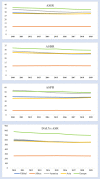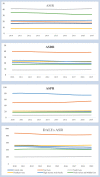Temporal trends of tracheal, bronchus, and lung cancer between 2010 and 2019, in Asian countries by geographical region and sociodemographic index, comparison with global data
- PMID: 37127553
- PMCID: PMC10290923
- DOI: 10.1111/1759-7714.14912
Temporal trends of tracheal, bronchus, and lung cancer between 2010 and 2019, in Asian countries by geographical region and sociodemographic index, comparison with global data
Abstract
Background: This study aimed to describe the trends in incidence, mortality, and burden of tracheal, bronchial and lung (TBL) cancer in Asia from 2010 through 2019 and compare with global and other continental data.
Methods: We collected TBL cancer data from the 2019 Global Burden of Disease (GBD) study from 2010 to 2019 in 49 countries and territories in Asia. For all locations, annual case data and age-standardized rates (ASRs) were used to investigate the incidence, prevalence, mortality, and disability-adjusted life-years (DALYs) of TBL from 2010 to 2019. The relative difference (%) between years was used to show comparative variations of ASRs for the indicators studied.
Results: In 2019, more than 55% of TBL cancer cases and deaths occurred in Asian countries. A total of 57% of lung cancer patients lived in Asia and almost 60% of the global burden of lung cancer was imposed on Asian countries. From 2010 to 2019, incidences, deaths, prevalence cases, and DALYs number of TBL cancer increased over 1.34-, 1.31-, 1.31-, and 1.26-fold, in Asia. During this period, the age-standardized incidence rate (ASIR), the age-standardized death rate (ASDR), the age-standardized prevalence rate (ASPR), and the age-standardized DALYs rate (DALYs ASR) of TBL cancer decreased by 1, 3, 4, and 4%, respectively. While at the same time, the decreasing trend of these rates globally and in America and in Europe happened faster. In 2019, age-specific incidence, death, prevalence, and DALY cases of TBL cancer were peaking at 65-74, 70-74, 65-69, and 65-69 years, respectively. In 2019, the highest ASIR, ASDR, and DALYs ASR of TBL cancer was observed in East Asia countries and the highest ASPR in high-income Asia Pacific countries. Central Asia and high-income Asia Pacific countries experienced a decreasing trend in ASIR and ASDR, and the South Asia countries experienced the highest increasing trend from 2010 to 2019. ASPR only decreased in Central Asia, and DALYs ASR only increased in South Asia. In 2019, among high sociodemographic index (SDI) Asian countries, Brunei Darussalam had the highest ASIR, ASDR, and DALYs ASR and the Republic of Korea had the highest ASPR. Among high-middle SDIs, Turkey and Georgia; among middle SDIs, China and Armenia; among low-middle SDIs, Mongolia and the Democratic People's Republic of Korea had the highest ASIR, ASDR, ASPR, and DALY ASR of TBL cancer. Among low SDI Asian countries, Pakistan had the highest ASIR, ASDR, ASPR, and DALY ASR of TBL cancer.
Conclusion: Most of the global burden of lung cancer occurs in Asian countries, and the decreasing trend of incidence, death, prevalence, and burden of this cancer in these countries is slower than in other regions. Therefore, the implementation of necessary measures in order to reduce the process of this cancer is considered urgent.
Keywords: Asia; Lungl; bronchus; burden; incidence; mortality; prevalence.
© 2023 The Authors. Thoracic Cancer published by China Lung Oncology Group and John Wiley & Sons Australia, Ltd.
Figures







Similar articles
-
Temporal trends of thyroid cancer between 2010 and 2019 in Asian countries by geographical region and SDI, comparison with global data.Aging Med (Milton). 2024 Jan 10;6(4):386-426. doi: 10.1002/agm2.12277. eCollection 2023 Dec. Aging Med (Milton). 2024. PMID: 38239716 Free PMC article.
-
Burden of esophageal cancer between 2010 and 2019 in Asian countries by geographical region and sociodemographic index: A comparison with global data.Thorac Cancer. 2023 Aug;14(24):2361-2407. doi: 10.1111/1759-7714.15026. Epub 2023 Jul 17. Thorac Cancer. 2023. PMID: 37455657 Free PMC article.
-
Epidemiological trends of tracheal, bronchus, and lung cancer at the global, regional, and national levels: a population-based study.J Hematol Oncol. 2020 Jul 20;13(1):98. doi: 10.1186/s13045-020-00915-0. J Hematol Oncol. 2020. PMID: 32690044 Free PMC article.
-
The changes in global burden of autoimmune diseases two years after the COVID-19 pandemic: a trend analysis based on the Global Burden of Disease Study 2021.J Transl Autoimmun. 2025 Apr 24;10:100289. doi: 10.1016/j.jtauto.2025.100289. eCollection 2025 Jun. J Transl Autoimmun. 2025. PMID: 40342869 Free PMC article. Review.
-
Global, regional, and national burdens of leukemia from 1990 to 2017: a systematic analysis of the global burden of disease 2017 study.Aging (Albany NY). 2021 Apr 4;13(7):10468-10489. doi: 10.18632/aging.202809. Epub 2021 Apr 4. Aging (Albany NY). 2021. PMID: 33820874 Free PMC article.
Cited by
-
Temporal trends of thyroid cancer between 2010 and 2019 in Asian countries by geographical region and SDI, comparison with global data.Aging Med (Milton). 2024 Jan 10;6(4):386-426. doi: 10.1002/agm2.12277. eCollection 2023 Dec. Aging Med (Milton). 2024. PMID: 38239716 Free PMC article.
-
Epidemiology and future trend predictions of ischemic stroke based on the global burden of disease study 1990-2021.Commun Med (Lond). 2025 Jul 3;5(1):273. doi: 10.1038/s43856-025-00939-y. Commun Med (Lond). 2025. PMID: 40610700 Free PMC article.
-
Global, regional, and national burden of idiopathic epilepsy in older adults, 1990-2021: a systematic analysis for the Global Burden of Disease Study 2021.BMC Med. 2025 Jul 28;23(1):443. doi: 10.1186/s12916-025-04268-8. BMC Med. 2025. PMID: 40722097 Free PMC article.
-
A comparative analysis of the burden, trends and inequalities of tracheal, bronchus, and lung cancer in India from 2000 to 2021: A systematic analysis for the Global Burden of Disease study 2021.PLoS One. 2025 May 7;20(5):e0322646. doi: 10.1371/journal.pone.0322646. eCollection 2025. PLoS One. 2025. PMID: 40333953 Free PMC article.
-
Global Burden of Tracheal, Bronchus, and Lung Cancer in Adults Over 55 Years Old Based on Socio demographic Status and Geographical and Gender Differences from 2010-2021.Thorac Res Pract. 2025 Jun 26;26(4):155-175. doi: 10.4274/ThoracResPract.2024.24081. Epub 2025 Jan 27. Thorac Res Pract. 2025. PMID: 39930698 Free PMC article.
References
-
- Vineis P, Wild CP. Global cancer patterns: causes and prevention. Lancet. 2014;383(9916):549–57. - PubMed
-
- Sung H, Ferlay J, Siegel RL, Laversanne M, Soerjomataram I, Jemal A, et al. Global cancer statistics 2020: GLOBOCAN estimates of incidence and mortality worldwide for 36 cancers in 185 countries. CA Cancer J Clin. 2021;71(3):209–49. - PubMed
-
- Ghoncheh M, Mohammadian M, Mohammadian‐Hafshejani A, Salehiniya H. The incidence and mortality of colorectal cancer and its relationship with the human development index in Asia. Ann Glob Health. 2016;82(5):726–37. - PubMed
MeSH terms
LinkOut - more resources
Full Text Sources

